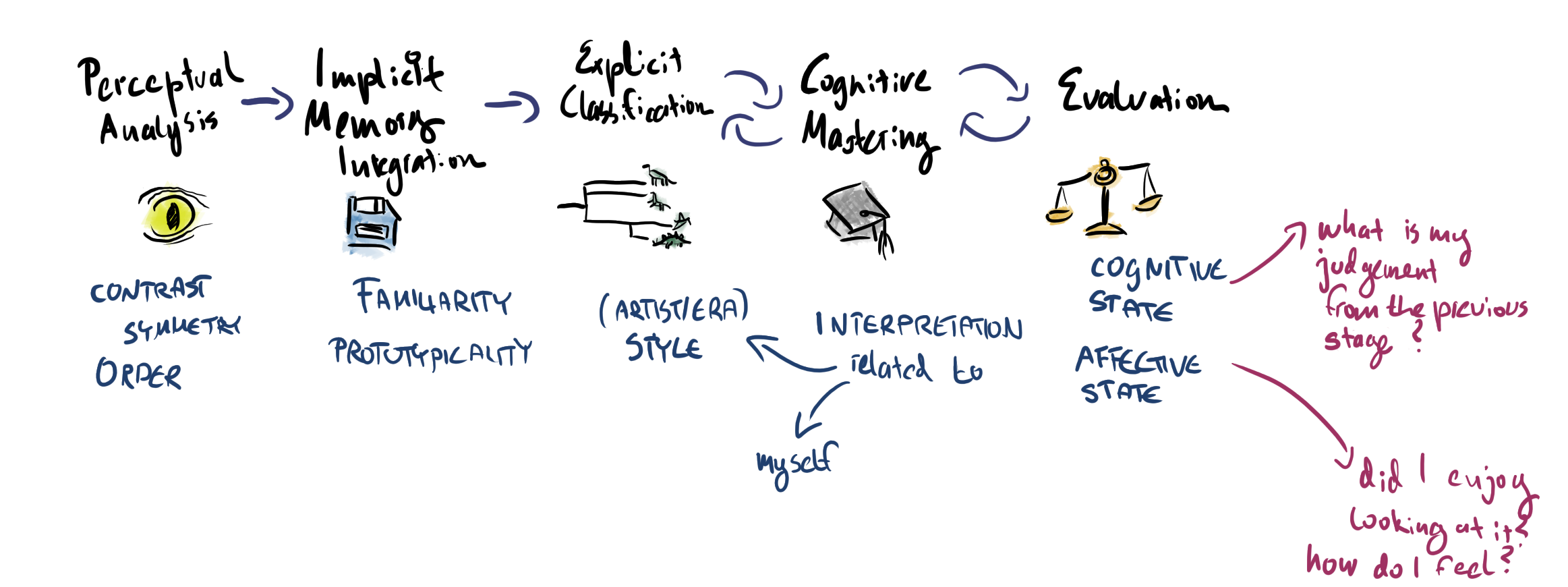As I was reading a nice proper UX paper, I innocently put author and date of an intriguing paper on aesthetics in the margins of my notebook. Now I am stuck in a quite deep academic rabbit hole of, broadly, art research. Oh well. Let’s get my thick reading list down by one.
Leder, Belke, Oeberst and Augustin noted that research on aesthetics appreciation (what makes people think stuff looks good) has been all but conclusive. Thus, that research area was in a bit of a collective “maybe it can’t be done” state of depression. The authors took a step to rectify this with a general model, and so A model of aesthetic appreciation and aesthetic judgments was born.

Intro & Paper
The paper is build around a single model of aesthetic experience, which is shown as an infographic quite early in the paper. It has the commendable academic property of being quite exhaustive in possible paths, interactions and side effects. Which also makes it quite complex. So, while keeping the original in mind for any academic research based upon this, I drew a simplified version. The steps are meant to describe to what happens within the viewer as she is having an aesthetic experience.

This is possibly borderline offensive in its level of simplification. However with myself being quite the dilettante on the whole topic, the overall broad outline of steps was what was most interesting to me. So, let’s dive in. All following chapters are simply more or less iterative steps of what happens when someone looks at art, as sketched above.
First Step: Perceptual Analyses
The stuff that happens when the brain sees anything. In milliseconds, certain “primal” features of (for example) an artwork are subconsciously observed and judged. At this stage, the following aspects are appreciated:
- Symmetry
- Contrasts
- Clear imagery
- Medium Complexity
- Gestalt principles
- Certain colors, probably
It is no aim of the paper to dive deep into these, so I think leaving them here in that google-able list is fine.
Second Step: Implicit Memory Integration
Next, the memory of our dear participant is activated! The following steps rely on the things the art viewer knows, has seen before, committed to her memory. However, if you would ask her, she probably could not answer what influences her judgement right now - thus, this stage is “implicit”.
Three core aspects influence the art experience at this point:
Familiarity
Did the viewer viewed something like this before? How often? How much like this? There is a long-standing body of research around the mere-exposure-effect, which lays a solid, if discussed and continuously evolved, groundwork for this.
Prototypicality
How representative is something of the class of things it belongs to? Meaning a judgement akin to ‘How much does this depicted evening beach scene look like an evening beach scene’.
Peak-Shift
Although empirical evidence here is weak, the authors also discuss the possibility of peak-shift or a search for essential features as potential influences in this stage of art viewing. Peak-shift simply means to exaggerate certain core features, like in newspaper cartoons.
Third Step: Explicit Classification
Now, cultural knowledge is mixed in. If the art viewer has a solid of definition of ‘Italian Renaissance Art’ in mind, she may judge the art work against that. If not, she does not. Big individual differences in judgement arise here.
As the authors point out, the explosion of styles in the last century blows this effect up even more. Often in modern and Modern art, every single artist has their own style. Thus, the result of this stage is largely dependent on the knowledge the viewer has of the specific artist’s style.
Fourth & Fifth Step: Cognitive Mastering and Evaluation
The authors group these two stages together due to the feedback loop between them. Alright, so will I. In my opinion, what is happening in this last step may be summarized as ‘finishing up my thoughts’ and requires not much further elaboration. Interesting however are the two resulting outputs that the authors propose:
Aesthetic Emotion / Affective State
How do I feel looking at this artwork?
This amotional state may change at several points during the process described above, and further may be affected by previous mood and other factors.
One interesting perspective is to consider the several stages, especially cognitive mastering, as a puzzle which the viewer does or does not solve. Unsurprisingly, successfully solving a ‘puzzle’ like ‘which period does this belong to’ is satisfying and will probably boost the affective state.
Aesthetic Judgement / Cognitive State
Is this artwork good?
The answer to this question is the ‘aesthetic judgement’. Strikingly, the authors propose that this judgement can be quite independent from the aesthetic emotion. Having successfully concluded that an artwork is trash can still be very satisfying, thus resulting in positive aesthetic emotion and negative aesthetic judgement.
Furthermore, the authors theorize that failing to separate these two outcomes may lead to diluted, misleading or weak results in studies. They urge to measure both or at least clearly measure one of them. Definitely a key takeaway from this paper for me.
Conclusion
I quite enjoyed the paper. It elaborated my own internal model of art perception quite a lot, and I am thankful for that. The authors propose that a similar model may be extended to realms such as sculptures or music. Sounds plausible. I would be surprised if some of these ideas could not be used in the field of UX as well. Of course, being a purely theoretical paper based on literary review is the weak point of the paper. But I am looking forward to see this model in action and I will definitely search for experimental implementations, which the authors propose for validation.
Thanks for reading! This post is part of my series of reading and summarizing papers, mostly relating to UX. I use a casual tone, because that’s the most fun to me. That means my interpretation of a given paper may be off. Or incomplete. Or plain wrong. Always think for yourself, and for the love of God, don’t cite this in an academic context. Use the original article instead. Cheers!